A fine line between drinking and drunkenness

THE RAKE'S PROGRESS III: THE ORGY
William Hogarth (1697-1764)
1732-1735
Sir John Soane's Museum, London
In the third image of the series The Rake’s Progress, William Hogarth presents a typical libertine: Tom, an incorrigible country rake who comes to London to spend his inheritance. At three o’clock in the morning, we find him in a tavern-come-brothel, the Rose Tavern on Drury Lane, near Covent Garden. In the midst of the orgy, Tom seems exhausted and ridiculous. “Foreign wines” have left him as drunk as a lord. A syphilitic prostitute takes advantage of his altered state to slip her hand inside his shirt, pulling out his pocket watch to show to her friends. Around the table, from left to right, two prostitutes take turns to spit; a servant carries a candle and a large tray, which will serve as a stage for the woman taking off her clothes. A woman sings ‘Black Joe’, a popular ballad published five years earlier.
On the walls, portraits of Roman emperors underline the parallels between the decadent underbelly of London and the excesses of the Roman Empire. These images appear alongside the portrait of Pontac, a famous London chef – another nod to sensual pleasure. François-Auguste de Pontac was sent to London by his father, Arnaud III de Pontac, in 1666, in order to open the city’s first restaurant, Pontac’s Head.
The food served in his establishment was much more elaborate than that previously available in the capital’s taverns. The restaurant was quickly to become a meeting-place for the nation’s thinkers and an ideal platform for the promotion of French wines from domains such as Haut-Brion and Pontac, creators of the “new French claret”.
16TH-17TH CENTURIES

AN ALLEGORY OF GLUTTONY or THE SHIP OF THE FOOLS (LA NEF DES FOUS) H. Bosch, ca. 1495/1500 - Musée du Louvre, Paris / 1

AN ALLEGORY OF INTEMPERANCE or ALLEGORY OF GLUTTONY Hieronymus Bosch, ca. 1495/1500 - Yale University, New Haven / 2
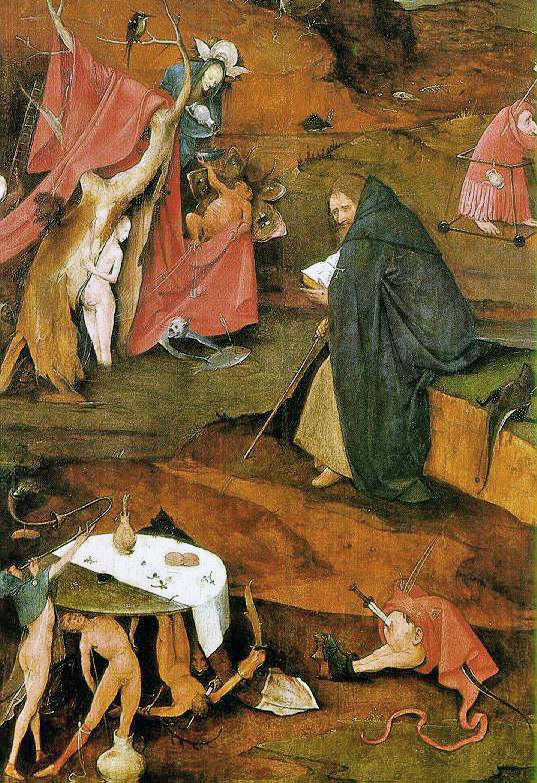
TEMPTATIONS OF St. ANTHONY (right panel) Bosch, ca. 1500 - Museu Nacional de Arte Antiga, Lisbon, Portugal / 3


AUTUMN or ALLEGORY AGAINST THE WINE ABUSE Sandro Botticelli, ca. 1490-1500 - Condé Museum, Chantilly, France
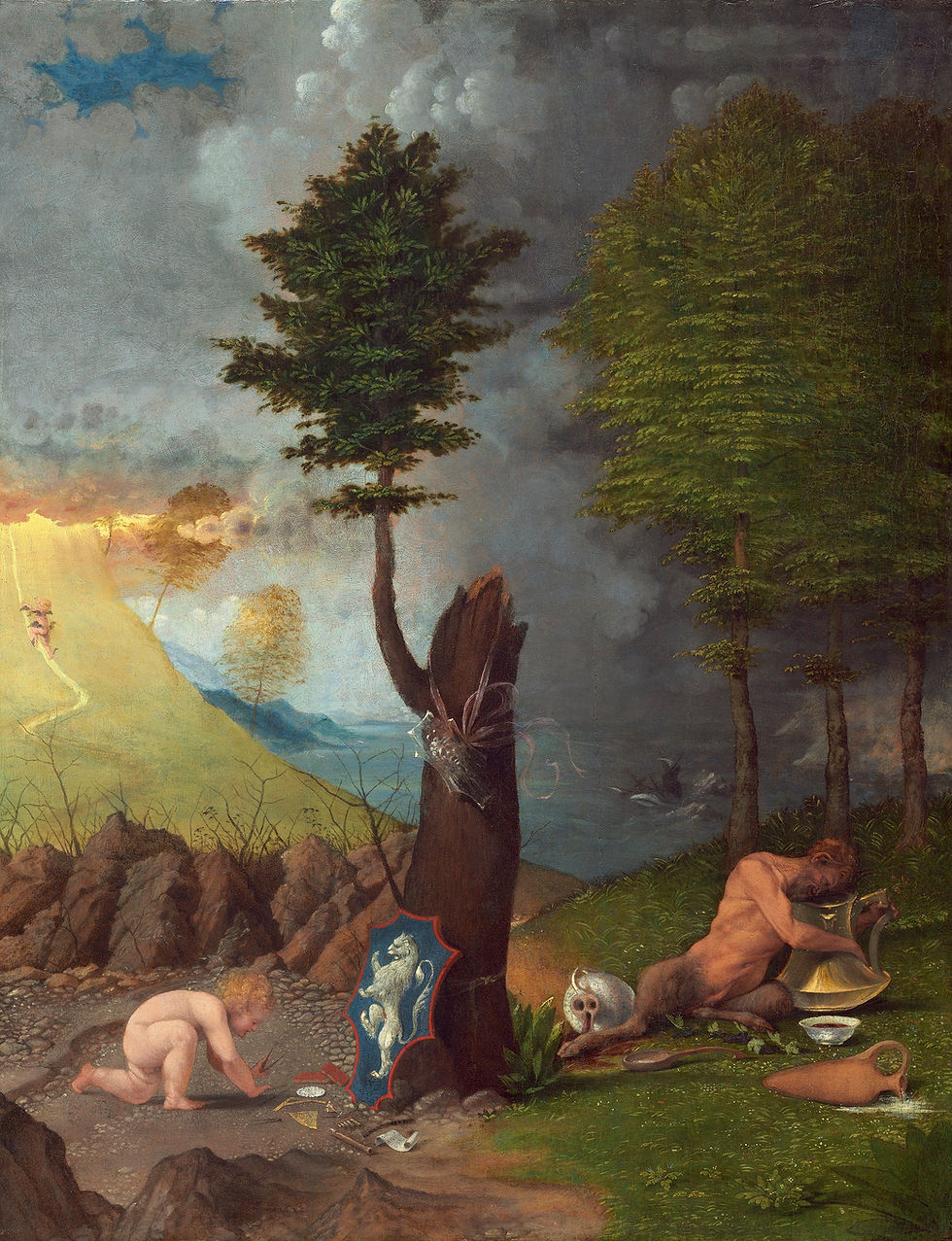
ALLEGORY OF VIRTUE AND VICE Lorenzo Lotto, 1505 - National Gallery of Art, Washington / 6

BOY DRINKING Annibale Carracci, 1582/1583 - Cleveland Museum of Art, OH, United States

THE THREE MUSICIANS Velázquez, 1616/17 - Gemäldegalerie, Staatliche Museen zu Berlin

HE CHEAT WITH THE ACE OF DIAMONDS Georges de La Tour, 1635 - Musée du Louvre, Paris / 9


CHEATING AT CARDS Jan Miense Molenaer ca. 1640/68 - Rijksmuseum, Amsterdam, The Netherlands

A WOMAN ASLEEP Vermeer, ca. 1656/57 - The Metropolitan Museum of Art, New York / 12

THE IDLE SERVANT Nicolaes Maes, 1655 - The National Gallery, Londres / 13

THE TIPPLER or THE WINE DRINKER (LA RIBOTEUSE ou BUVEUSE DE VIN) Gabriel Metsu, 1655/57 - Musée du Louvre, Paris
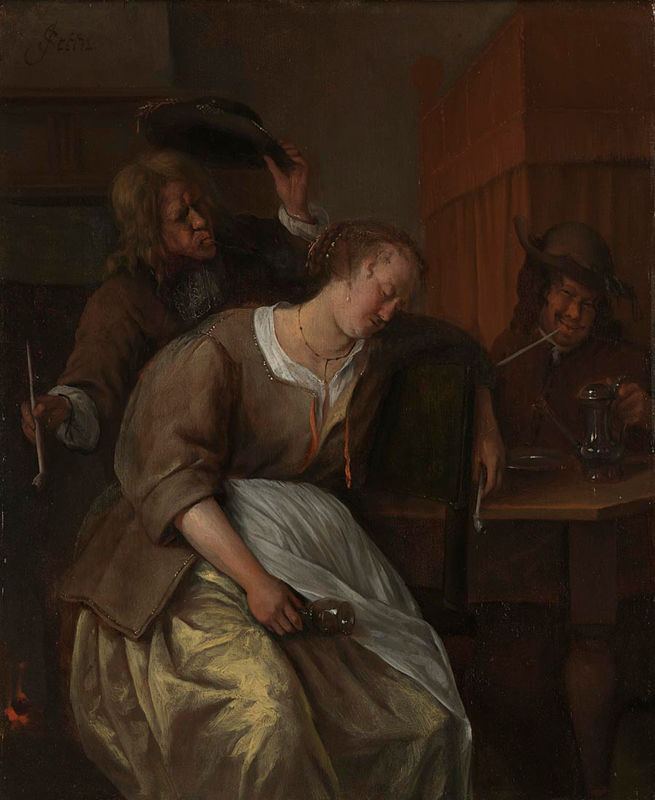
A MAN BLOWING SMOKE AT A DRUNKEN WOMAN Jan Steen, ca. 1660/65 - National Gallery, London / 15


THE KERMIS AT THE HALF MOON INN David Teniers the Younger 1641 - Gemäldegalerie, Dresden, Germany / 17

'A PIG BELONGS IN THE STY’ Jan Steen, ca. 1673/75 - Mauritshuis, The Netherlands / 18

'A PIG BELONGS IN THE STY’ Jan Steen, ca. 1673/75 - Mauritshuis, The Netherlands / 19

THE DRUNKEN COUPLE Jan Steen, ca. 1655/65 - Rijksmuseum, Amsterdam / 20

THE EFFECTS OF INTEMPERANCE Jan Steen, ca. 1663/65 - The National Gallery, London / 21

THE DISSOLUTE HOUSEHOLD Jan Steen, ca. 1663/64 - The Metropolitan Museum of Art, New York / 22

WINE IS A MOCKER Jan Steen, 1663/64 - Norton Simon Museum, Pasadena, CA, United States / 23

THE TOPSY-TURVY WORLD or IN LUXURY, BEWARE Jan Steen, 1663 - Kunsthistorisches Museum, Vienna, Austria / 24
> Click on the icons for a closer look at the artworks
1-2-3. Some surprising works were intended to enforce the religious morality of the period. The theme of mortal sin is presented in the context of the seven deadly sins – the root of all evil. From the fifteenth to the seventeenth century, the seven deadly sins were taken as inspiration by artists for moral allegories. In his nightmare landscape Allegory of Gluttony and Allegory of Intemperance - Find out more: see the work in context -, Hieronymus Bosch denounces overindulgence in general and drunkenness in particular. In The Temptation of Saint Anthony, Bosch represents the influence of Satan on mankind and the struggle of individuals to choose between good and evil. Lust, gluttony and wine tempt the hermit; the wrong decision could destroy him. The art historian Wilhelm Fraenger quotes the Book of Deuteronomy (32:33): “their wine is the poison of dragons, and the cruel venom of asps.”
6. Lorenzo Lotto’s panel Allegory of Virtue and Vice was intended to protect the portrait of his patron Bernardo Rossi. Two opposing “moral landscapes” surround the bishop’s coat of arms: on the right, the ‘path of virtue’ is symbolized by a busy child in the foreground, who is shown in a sunlit field at a safe distance from the sharp rocks and thorn bushes. To the right, the ‘road to vice’ is symbolized by a drunken satyr lying under a tree.
9. Many artists simply wished to remind their audiences that sinners were barred from Heaven. Over a century later, George de la Tour’s Cheat with the Ace of Diamonds elegantly illustrates the opposition between innocence and vice. The young man shown in this 'chic' painting is subject to the period’s three major temptations: gambling, wine and lust. Find out more: see the work in context >>
12. Women drinking wine embody vice in many of Vermeer’s works. Vermeer paints, in a moving and elegant way, the private life of women. He would go on to dedicate seven of his 35/36 known works to the ill-effects of wine. If Young Woman Sleeping illustrates the risks of overindulgence, Vermeer’s other paintings show wine as an instrument of seduction (see Gallery Seduction and Love). Wine acts as a love potion with two possible outcomes for the consumer – either obsessive, all-consuming love or melancholic lassitude... “The young woman appears to be asleep. From her elegant clothes, we can suppose that she is the mistress of the house rather than a servant (as is often suggested – Ed.). Her position, head in hands, is open to interpretation. She may be melancholic, but it is more likely that she is suffering from acedia, the classic state of indolence. In Middle-Age theology, this was considered a mortal sin. In a period where the religious authorities enforced a rigid work ethic, women who failed to adhere to these norms were thought to have broken religious law. The mother figure was supposed to be God-fearing, an embodiment of Chistian virtues and a good example for the servants. Acedia is often seen as a consequence of drunkenness. This woman’s overconsumption of wine has clearly led to her extramarital affair. The painting on the wall is part of the mise en scène. The painting shows a work of Cesar Van Everdingen, representing the unmasking of a cherub, Eros. Vermeer owned Van Erverdingen’s painting and the image reappears in The Music Lesson Interrupted. Delft jugs are ubiquitous in Vermeer’s scenes. They contain wine, a love potion seductive to women.” (Source: Robert Schneider, Vermeer, Taschen).
13. Vermeer was doubtless inspired by contemporary Dutch genre scenes, such as Nicolaes Maes’ The Idle Servant, on display in the National Gallery. This painting also explores the theme of acedia, albeit in a different social context. Here, it is the servant who has drunk her employer’s wine to the detriment of her work, as we can see from the dishes on the floor and the cat eating the chicken.
15 to 24. “All drunkenness oscillates between two extremes, causing the drinker to alternate between exuberance and exhaustion, explosion and depression. Drunkenness is a state of contrasts which alternates joy with sadness.” Other Dutch painters confirm this. Experienced in painting scenes of popular revelry (like Jan Sanders van Emessen, David Teniers, etc), they show us men and women falling over or passed out, like in Jan Steen’s Argument over a Card Game, The Drunken Couple, and The Effects of Intemperance.
In The Topsy-Turvy World (In Luxury, Beware)..., "Jan Steen arranges the various actors as though on a theater stage. The gentle depth of the composition is based on a triangle, with the magnificently dressed young woman at its top point. Her clothing and seductive look identify her as a “loose-living” girl. She, however, is not the focus of the scene; that is provided by the lady of the house, who has fallen asleep at the table on the left. Her “absence” has resulted in the rest of the story: the dog is finishing the meat pie that was served on the table, one of the children is filching something from the cabinet on the wall (“opportunity makes the thief ”), the little girl’s brother is trying out a pipe, and the youngest child, sitting in his highchair, is playing carelessly with a string of pearls. His attention diverted to the side, a young man is trying to play a violin. Young people who continued to live at home were considered suspect in the popular culture of the Netherlands at the time. The prostitute in the foreground has already been mentioned: in a rovocative gesture she holds a filled glass between the legs of the man of the house, while he dismisses with a grin the admonishment of the nun (a Beguine?) standing on the right. The duck on the shoulder of the man next to her identifies him as a Quaker, who urges the reading of pious texts. Finally, the pig in the doorway to the kitchen is an allusion to another proverb: “Neither cast ye your pearls [here: roses] before swine”. Hanging above the heads of these sinners are the symbols of the penalty to be expected for unbridled, lustful behaviour: a sword and a crutch in a basket suspended from the ceiling. The painting’s traditional German title “Die verkehrte Welt” (“The Topsy-Turvy World”) is not completely in accordance with the content, because this is really a humorous warning against one of the seven deadly sins, luxuria extravagance, later lust). An interesting biographic detail: at times Steen had to earn a living by running an inn and a brewery" (© Cäcilia Bischoff, Masterpieces of the Picture Gallery. A Brief Guide to the Kunsthistorisches Museum, Vienna 2010).
18TH CENTURY

LUNCHEON PARTY IN A PARK (Replica of LUNCHEON WITH HAM, Chantilly, France) Nicolas Lancret, ca. 1735 - MFA, Boston / 1

A MIDNIGHT MODERN CONVERSATION William Hogarth (after), ca. 1732 - Yale University, New Haven, CT, USA

‘RUMOR ERAT IN CASA’ (THERE WAS A COMMOTION IN THE HOUSE) Cornelis Troots, 1740 - Mauritshuis, The Hague, The Netherlands / 3

THE BRILLIANTS Thomas Rowlandson ca. 1801 - The Art Gallery of South Australia, Adelaide, Australia

THE DRUNKEN COBBLER, Jean-Baptiste Greuze 1776/79 - Portland Art Museum, Portland, OR, United States / 5
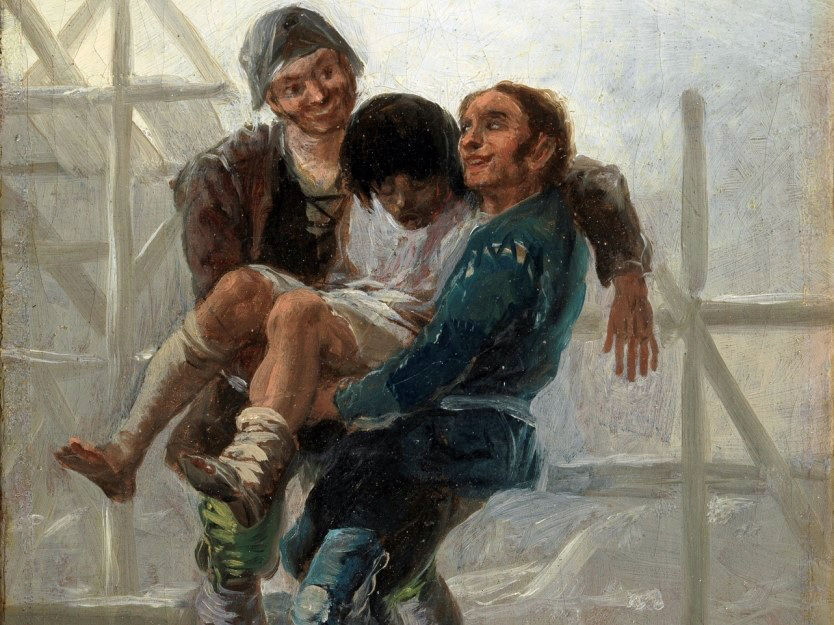
THE DRUNKEN MASON (detail) Goya, 1786 - Museo del Prado, Madrid, Spain / 6
> Click on the icons for a closer look at the artworks
1. One century later, drunkenness had become part of the lifestyle of the Parisian aristocracy. Such behaviour, considered a serious lapse in refinement, was still subject to strong condemnation. Champagne-drinking, however, enjoyed a special status, and as such was exempt from such negative commentary. It was connected to intoxication, but also to sensual pleasure, collective joy and even medical benefits: “Angry clouds no threat to the feast / In the stomach no tempest / It is tender, it is clean, delicate, and light”. This ‘approved debauchery’ is shown in Nicolas Lancret’s Lunch of Ham, commissioned by Louis XV. The painting is exhibited at the Musée Condé, in the Château de Chantilly.
4. Cornelis Troost is one of the rare Dutch artists to have adapted his native style to the new century, as well as fitting traditional genre painting to new fashions, inspired both by French-style fêtes and Hogarthian humour. His alert, incisive eye scrutinises the mores of contemporary society.
5. Drunkenness was not the preserve of the aristocracy. In the second half of the 18th century, the problem of excessive drinking forced the French government, as well as thinkers such as Diderot, to push for the return of a more virtuous way of life. Both literature and painting were to encourage good behaviour. After scenes of dissipation and flirtation in previous Salons (of which Diderot was a noted critic from 1759 to 1781), virtue and morality were brought back to the fore.
Jean-Baptiste Greuze, a self-taught genre painter from Tournus, was one of the most notable painters of this period, thanks to his natural and lifelike representation of people and compositions. The simplicity and honestly of such subjects ensured that his ‘edifying’ paintings enjoyed great success. With The Drunken Cobbler, Greuze warns of the consequences of drunkenness through the following adage: “the cobbler’s children never have shoes”. They join their mother in admonishing their father.
6. A drunken mason is carried off the building site by two of his companions, who cannot repress their smirks at the drunk´s situation: he lacks his trousers and his stockings have fallen down.
19TH CENTURY

MONKS MERRYMAKING John Cranch, ca. 1804 - The Tate Britain, London / 1

THE VILLAGE HOLIDAY Sir David Wilkie, 1809/11 - Tate, London / 2

HARVEST HOME Joseph Mallord William Turner, ca. 1809 - Tate, London

FIVE POINTS Unknown artist, ca. 1827? - The Metropolitan Museum of Art, New York / 4

THE RAFT OF THE MEDUSA Théodore Géricault, 1818/19 - Musée du Louvre, Paris

FACING THE ENEMY Francis William Edmonds 1845 - Chrysler Museum of Art, Norfolk, VA, United States

AFTER A LONG CRUISE John Carlin, 1857 - The Metropolitan Museum of Art, New York / 7

TWO DRINKERS Honoré Daumier ca. 1858 - The Barnes Foundation, Philadelphia, PA, United States

THE DRINKERS Daumier, 1861 - The Metropolitan Museum of Art, New York / 9

FALSTAFF WITH A TANKARD OF WINE AND A PIPE Mihaly von Zichy, 1873- The Hermitage Museum, St Petersburg / 10

IN A CAFE (DANS UN CAFÉ) Edgar Degas, 1873 - Musée d'Orsay, Paris / 11
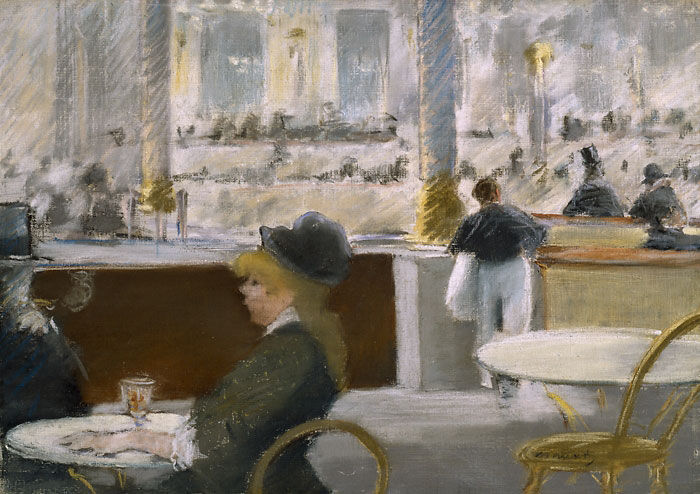
A CAFE, PLACE DU THEATRE FRANCAIS (L’INTÉRIEUR D'UN CAFÉ, PLACE DU THÉÂTRE FRANÇAIS) E. Manet, ca. 1880 - Glasgow Museums, UK / 12
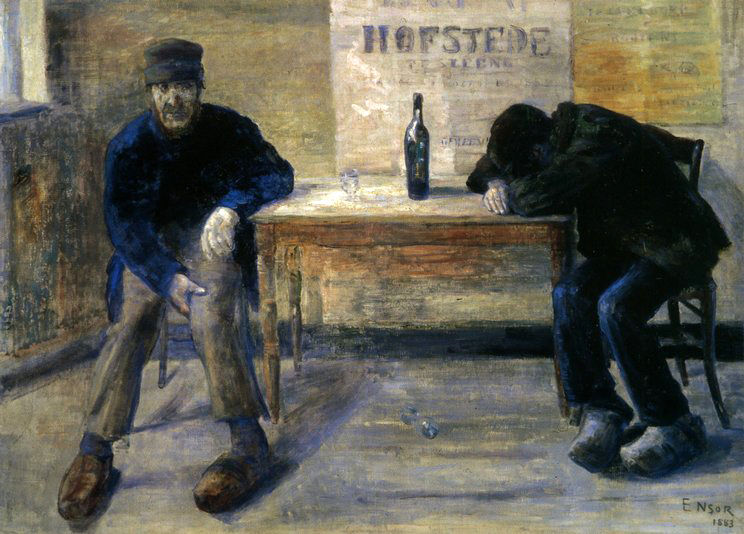
DRUNK MEN (LES POCHARDS) James Ensor, 1883 - Belgium Royal Museums, Brussels, Belgium

THE DRUNK (L'IVROGNE) Eugene Laermans 1898 - Belgium Royal Museums, Brussels / 14

AFTER THE BALL, THE REVELER Jean-Louis Forain 1882 - Dixon Gallery and Gardens, Memphis, TN, United States

SELF-PORTRAIT WITH GLASS Van Gogh, 1887 - Van Gogh Museum, Amsterdam, The Netherlands

THE DRINKERS (LES BUVEURS) Vincent Van Gogh, 1890 - The Art Institute, Chicago / 17

DRINKER (BUVEUR) Henri de Toulouse-Lautrec, 1882 - Private collection / 18

THE HANGOVER, SUZANNE VALADON (GUEULE DE BOIS, La Buveuse) Toulouse-Lautrec, ca. 1886 - Fogg Art Museum, Cambridge, MA, USA / 19

AT CAFE LA MIE Henri de Toulouse-Lautrec, c. 1891 - MFA, Boston / 20
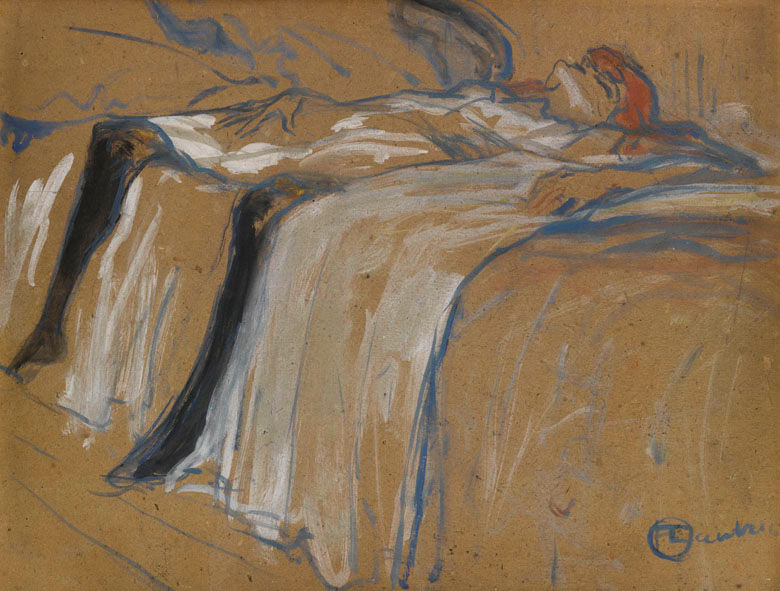
ALONE (SEULE) Henri de Toulouse-Lautrec, 1896 - Musée d'Orsay, Paris
> Découvrez les oeuvres dans leur entier en cliquant sur les vignettes
1. "Since the middle ages monks had a reputation for indulgence. In Protestant England they were an especially common target for satire, representing everything that was deemed to be corrupt within the Catholic church" (Source: Tate). These monks are merrymakers in a very festive mode. They drink a lot and are very probably drunk. Unexpectedly, a woman is also seated around the table. She is laughing and giving one of the monks a promising look.
2. Outside a pub, a drunk man hesitates between going home to his wife or staying to drink again with his friends.
4. Five Points was a slum on the Lower East Side of Manhattan. Declared in 1858 in the New York Herald a “nest of drunkenness, roguery, debauchery, vice, and pestilence,” the neighborhood was home to a combustible mix of New York’s poorest citizens: recently arrived (predominantly Irish) immigrants, unskilled laborers, and African Americans. Highlighting the district’s renowned chaos and vulgarity, the figures in the painting fight, flirt, and generally misbehave amid dilapidated buildings. Although the artist has not been identified, this image is well known, having been reproduced as a lithograph in a 1855 guide to New York City (Source: The Metropolitan Museum of Art)".
7. "After a Long Cruise, a comic view of daily life on a dock, displays the bawdy humor popular at mid-century. Three drunken sailors wreak havoc by accosting a well-dressed black woman and knocking over a fruit-and-nut vendor’s stand" (Source: The Metropolitan Museum of Art).
9. Alcohol is represented by Daumier as an escape offered to the poor.
10. Alcohol, including wine, was often represented as a plague ravaging society. The nineteenth-century artist Mihaly von Zichy presents the evils of drink in his painting Falstaff with Jug of Wine and Pipe. This sympathetic Shakespearian character (1597) is a confirmed alcoholic. Sack (xeres) is his chosen poison: “If I had a thousand sons, the first humane principle I would teach them should be, to forswear thin potations and to addict themselves to sack.” (Henry IV, Part 2, Act IV, Scene 3). Falstaff’s choice of words shows the pride he takes in his addiction.
11. In the daring Dans un Café, Edgar Degas shows us the widespread problem of alcoholism. The painting shows a man and a woman sitting in a bar. The woman seems mournful; her clothes are worn and her expression sad. She has the slouching shoulders and pale face of an absinthe-drinker. The man looks away from her, his own face ravaged by wine... He is drinking coffee considered as a remedy! The extreme solitude of the characters strikes the viewer. Exhibited for the first time in London in 1876, Degas’ painting caused a scandal among the Victorian public. Despite this, the bar scene – which dates back to seventeenth-century Dutch painting – was nothing new. It was, rather, Degas’ realism that shocked. The artist’s penetrating, critical eye condemns contemporary society. The painting has a connection with Zola’s novel L’Assommoir; the author himself wrote to Degas to confirm that “I have described in great detail, on more than one of my pages, certain of your paintings”. This realistic ‘slice of life’ may have also influenced Manet and Toulouse-Lautrec.
12. Manet uses a broader perspective in Interior of a Café, Place du Théâtre Français. The only customer is a woman, probably an alcoholic, gazing into the middle distance. The bar has only just opened, but already she is feeding her dependence.
14. At the end of the 19th century, helped by the abundance of cheap wine, alcoholism caused great problems for the poorest in society, in Belgium as in France. From the very start of his painting career, Eugène Laermans demonstrated a realism that was both social and humanitarian; his compositions frequently focused on workers and peasants. Here, he illustrates alcoholism, which was a theme also treated by other Belgian painters of the period (such as Henry de Groux and James Ensor). The first victims of this drunkard are his wife and children (as in Greuze’s Drunken Cobbler). The scene takes place in winter, and the family is shown in the foreground. Behind them, on the other bank of the river, we can see smoking factory chimneys. The drunkard, almost unconscious, walks mechanically, supported by his wife. She is thin, her eyes tired and resignation visible in her expression; the couple’s young daughter, her face older than her years, watches the terrible display. This addiction, this “second nature”, evokes Aesop’s fable of The woman and the drunkard.*
17. During his stay at the Saint Rémy Asylum, near Arles, Vincent Van Gogh copied works by his favorite artists. This included an engraving by Honoré Daumier, Physiology of the Drinker: The Four Ages. Van Gogh’s copy is entitled Drinkers, which partly hides the allegorical intention of the original work. The oldest protagonist (in the middle) gulps his wine, while the middle-aged man drinks beer. The young man (on the right) postures while downing his glass of absinthe. The etching demonstrates a famous Dutch proverb that Van Gogh, who was Dutch too, would have recognized: ‘as the old sing, so the young pipe’, already illustrated by Jan Steen (see gallery: Celebrations and Social Life) . The young boy greedily drinks a glass of milk. An addiction for every age!
18. The Drinker, a youthful work by Toulouse-Lautrec, rings strikingly true. Already an alcoholic and proud of it (“I’ll drink milk the day cows graze in the vineyard”), the artist paints what he knows.
19. Suzanne Valadon was the mistress and model of Toulouse-Lautrec, who gave her painting lessons. She was the model for The Hang-over, a portrait of an isolated working-class woman crushed by alcohol. Valadon would become the first female painter to be admitted to the Société Nationale des Beaux-arts.
20. This painting’s title comes from the former French slang expression “un miché à la mie” (literally, a “crumbly roll”), which referred to clients of prostitutes who neglected to pay for their services.
* There was a woman whose husband was always drunk, so she came up with a plan to cure him of his drinking problem. After he had passed out one night and was sleeping the sleep of the dead, she picked him up and carried him on her shoulders to the common cemetery. Then she put him down on the ground and left him there. She waited until he had time to sober up, then she went and knocked at the entrance to the cemetery. Her husband shouted, 'Who's there?' She answered, 'I am the one who brings food to the dead.' Her husband shouted back, 'I don't want anything to eat, but bring me something to drink, my good man! It pains me to hear you speaking of food but saying nothing about a drink!' The woman then beat her breast and exclaimed, 'Woe is me! My ingenuity has not accomplished anything! O my husband, you have not simply failed to learn your lesson: you are actually even worse than before. Your problem has turned out to be permanent!' This fable shows that people should not regularly engage in bad behavior because at a certain point the habit will impose itself permanently, even if they do not want that to happen. (Aesop's Fables, translated by Laura Gibbs 2002, The Woman and her Drunken Husband)
20TH CENTURY

THE DRUNKARD Joaquín Sorolla, 1910 - National Gallery, Londres
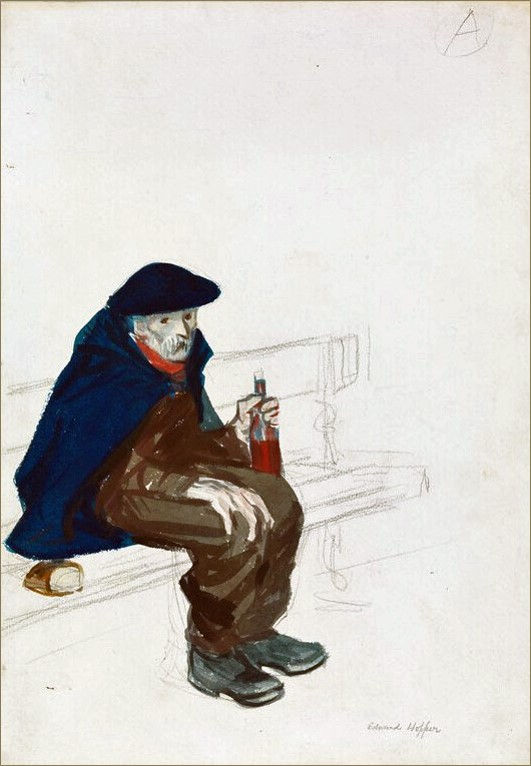
PARISIAN WITH WINE BOTTLE AND LOAF OF BREAD E. Hopper, 1906/07 - Whitney Museum of American Art, New York / 17

FRENCH COUPLE ON EMBARKMENT, After Guillaume Edward Hopper, 1909/10 - Whitney Museum, New York

SOUTINE Amedeo Modigliani, 1917 - National Gallery of Art, Washington DC / 18
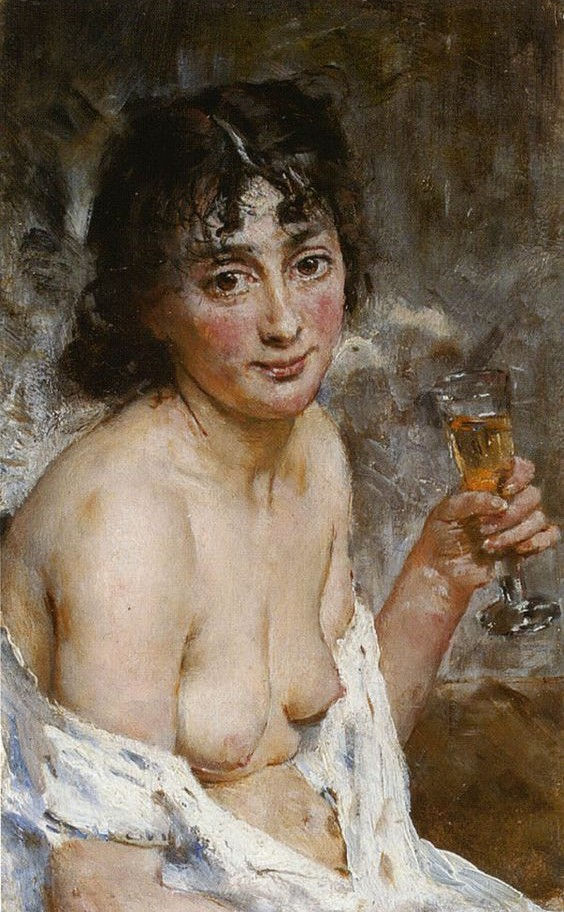
THE CHAMPAGNE GIRL Hans Heyerdahk, 1880-1881 - Drammens Museum, Norway / 18

THE DAY AFTER Edward Munch, 1894-1895 - Nasjonalgalleriet, Oslo, Norway / 15

THE SCREAM Edward Munch, 1910? - Munch Museum, Oslo, Norway

SELF-PORTRAIT WITH BOTTLES Edward Munch, 1938 - Munch Museum, Oslo, Norway
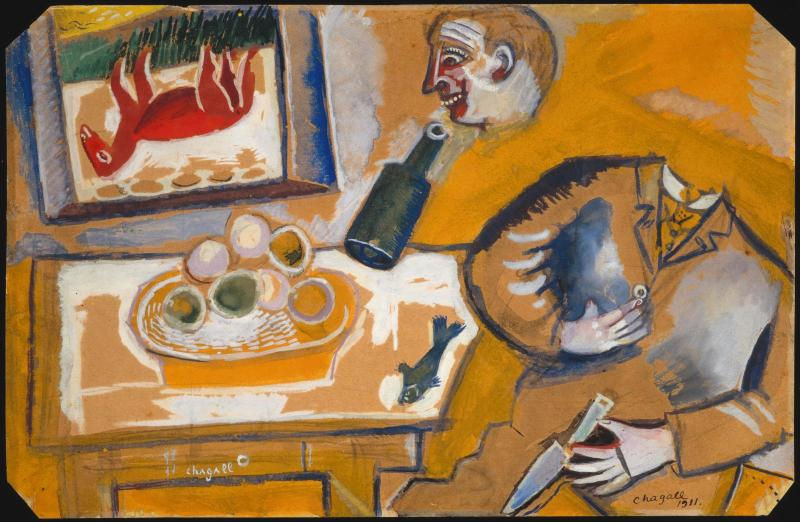
THE SOÛL Marc Chagall, 1911 - Pompidou Center, Paris

DRUNKARD Marc Chagall, 1912 - Private collection

THE DRINKER, SELF-PORTRAIT Ernst Ludwig Kirchner 1914 - Germanisches Nationalmuseum, Nuremberg, Germany

MEMORIES OF THE HALL OF MIRRORS IN BRUSSELS Otto Dix, 1920 - Musée National d'Art Moderne, Pompidou Center, Paris

THE RAKE'S PROGRESS V: AT THE BRASSERY (Watercolor) Edward Ardizzone, 1931 - Tate, London

DRUNKARDS Mikulas Galanda, 1935/36 - Turiec Gallery, Martin, Slovakia

DRUNKARD Mikulas Galanda, 1935/36 - Nedbalka, Bratislava, Slovakia

SALOON BAR Edward Le Bas, 1940 - Tate, London

DRUNKEN Asger John, 1946 - Mantova Museo Urbano Diffuso, Mantua, Italy
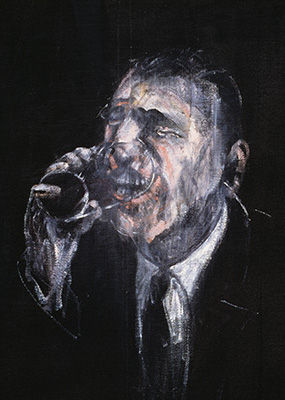
MAN DRINKING Francis Bacon, 1955 - Private collection

PORTRAIT OF GEORGE DYER IN A MIRROR Francis Bacon, 1968 - Musée Thyssen-Bornemisza, Madrid, Spain
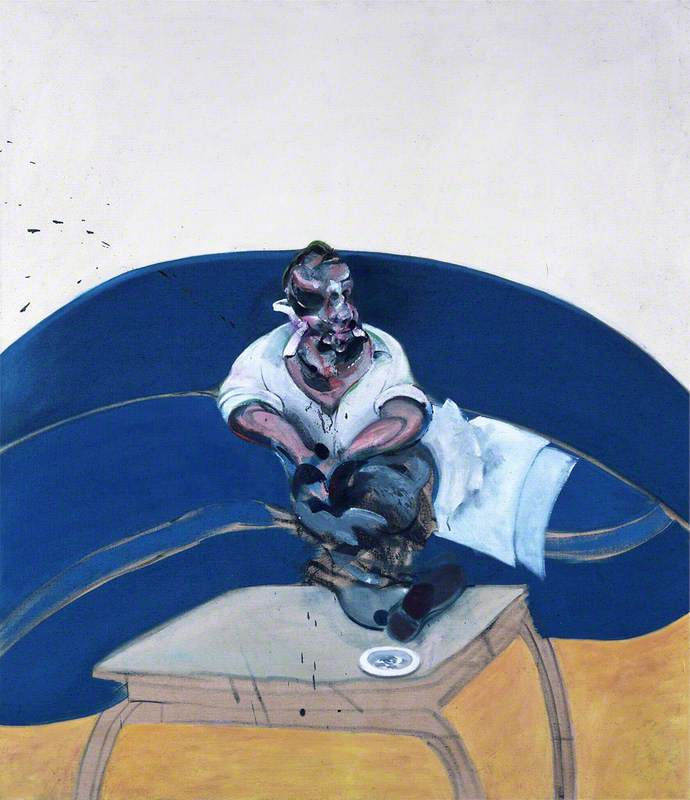
STUDY FOR SELF-PORTRAIT Francis Bacon, 1963 - National Museum Wales, Cardiff, Great Bitain

DRINKER WITH GLASS Georg Baselitz, 1981 - König Collection, Houston, TX, United States
> Découvrez les oeuvres dans leur entier en cliquant sur les vignettes
2. This drinker on a bench is one of Hopper’s representations of daily life in Paris, collected during three visits between 1906 and 1910. The man is a tramp, for whom daily misery is punctuated by benches, bread and wine.
4. Modigliani and Soutine developed a close friendship. Both were struggling with poverty, drinking and drug. Modigliani painted Soutine's portrait several times. « Soutine's unruly, spontaneous manner of painting was alien to his Italian friend, who, to describe his own state of drunkenness, once quipped, ‘Everything dances around me as in a landscape by Soutine’"( Source : National Gallery of Art, Washington).
5. Hans Heyerdahl’s The Champagne Drinker may have inspired Munch (picture below), to the extent that we might as well rename the painting. Why not change its name to The Night Before…?
6. The title of Edvard Munch’s painting The Morning After is eloquent enough. But Day After Drinking (its other title) is more than a simple anecdote. It represents a life ruined by alcohol, like the life of Munch himself.
GALLERIES DRUNKS OR CONNOISSEURS
> Wine and Painting > From Drinking to Savoir-boire > Drunks or Connoisseurs > Drunkenness



